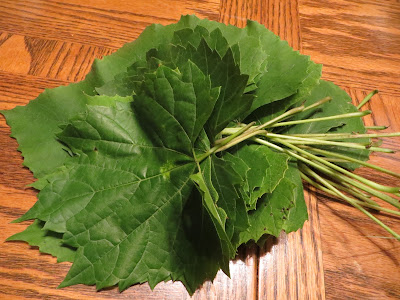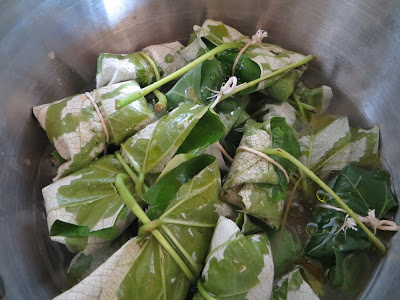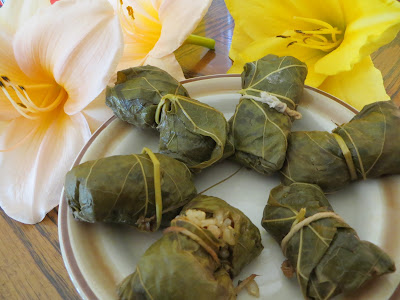Yum! Stuffed grape leaves! But they're only good before the leaves get tough from sun exposure or before they get " too old", like in July or later. To find the best grape leaves, look under the plants and preferably in the shadows or areas where the sun doesn't reach much. The easiest grape leaves for wrapping are the ones with the longer stems, but that can pose a problem as the longer stemmed ones are often the not so tender ones.
To make the stuffed grape leaves, I picked a number of tender leaves, rinsed them well in water and then soaked them for 30 minutes (to further soften them) while I was whipping up the "stuffing".
The "stuffing" is quite simple:
1 small onion finely diced
1 medium-large tomato, diced (removing skin is optional)
5-6 garlic cloves, minced
2-3 cup brown rice (takes longer to cook but has richer flavor -
the brown rice cooks faster if allowed to marinate in the other flavors for 30 min or so)
2 T. fresh lemon juice
small amount of lemon zest (optional)
salt and black pepper to taste
Put 1-2 tablespoons on each grape leave and tuck the leaves around, to finally wrap the long stem around the outside "package" and hopefully tuck the stem end under the stem on the other side to lock it in place. The grape leaves will unwrap if not secured, so I have also used thread or a clean string (as can be seen in the final picture).
Once the grape leaves are all stuffed and securely tied, pour water over them to cover and then liberally pour on olive oil. Turn on low heat and allow to simmer-cook, approximately 50 minutes (brown rice takes longer to cook). Watch the pot and add water if necessary to keep the leaves from scorching.
Place on a serving dish and serve. Removing the tough stem and certainly the string before serving might be a good aesthetic choice.







Comments
Post a Comment